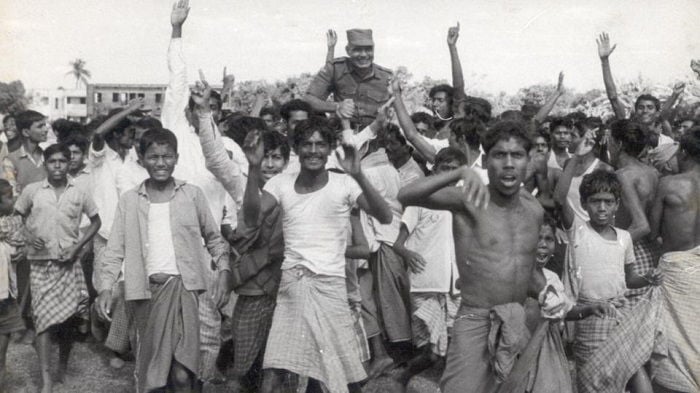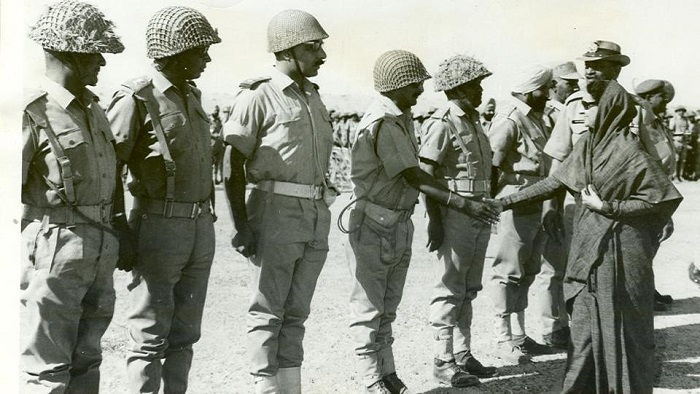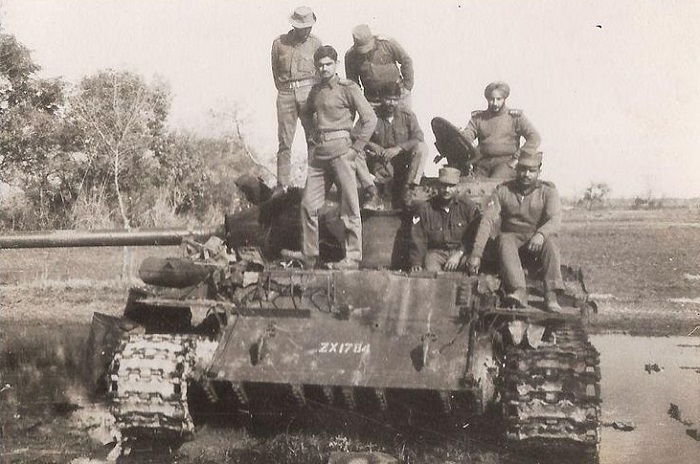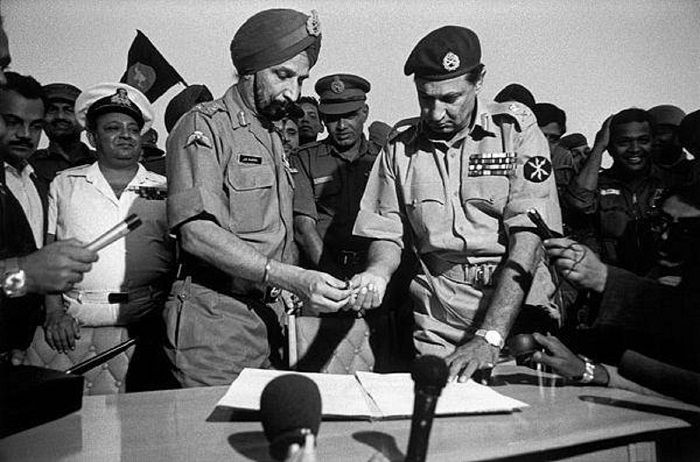The Indo-Pakistan War of 1971, counted among the shortest wars in history, was a military combat between India and Pakistan that took place during the Bangladesh liberation war in East Pakistan. The Indo-Pakistani War started after Pakistan launched pre-emptive aerial strikes on eleven Indian Air Force stations in North India on December 3, 1971. This marked entry of India into the Bangladesh liberation war in support of the Bengali nationalist forces and beginning of the nation’s hostilities with Pakistan. Conflicts on both the eastern and western fronts followed and eventually India garnered air supremacy in the eastern theatre. The allied forces of India and Bangladesh made a quick advance and the war ended on December 16, 1971 in Dhaka after the Instrument of Surrender was signed by the Eastern Command of Pakistan military resulting in independence of East Pakistan and its emergence as a new nation called Bangladesh. The conflicts claimed thousands of lives and witnessed a systematic campaign of genocidal rape by the Pakistani soldiers and the Razakars while millions of people fled from Bangladesh to take refuge in India. Thousands of Pakistani servicemen were taken prisoners by the Indian Army
Circumstances Leading to Indo-Pakistani War
Liberation Struggle of East Pakistan
The independent federal dominion of Pakistan included two enclaves, East Pakistan (presently Bangladesh) and West Pakistan (modern-day Pakistan) which were geographically separated by a distance of more than 1,000 miles (1,600 km). Pakistan was facing difficulty in administrating the two unequal polities which were not only geographically distanced but also had linguistic and cultural differences. Problem in integrating the two wings resulted in political tensions between East Pakistan and West Pakistan since the very creation of Pakistan in 1947 which included the 1950 Bengali language movement that advocated for recognition of the Bengali as an official language of Pakistan; the 1964 East Pakistan riots that witnessed ethnic cleansing of Bengali Hindus; and the 1969 protests following which President of Pakistan Ayub Khan resigned and invited Yahya Khan, the Pakistani army chief General to take charge of Government of Pakistan.

Image Credit: https://www.hindustantimes.com/photos/india-news/in-pics-looking-back-at-the-indo-pak-war-of-1971/photo-n3Bw8zepkRWosKrOzYqI8K.html
The first general elections held in Pakistan on December 7, 1970 saw a landslide victory of East Pakistan’s Awami League that won an absolute majority of 167 seats out of 169 in the East Pakistan Legislative Assembly and almost an absolute majority in the 313-seat National Assembly. The Pakistan Peoples Party (PPP) won most of the votes in West Pakistan with 81 seats in the National Assembly. The leader of Awami League, Sheikh Mujibur Rahman spearheaded the Six Point Movement that stressed on greater autonomy for East Pakistan. He also advocated for the right of Bengali’s to govern. The PPP and President Yahya Khan however were not in favour of having a party from East Pakistan in government thus the Assembly session was not held.
The issue of right to governance and the constitution of Pakistan between the East Pakistan Bengalis and the multi-ethnic West Pakistanis eventually initiated a massive unrest in East Pakistan that in no time took shape of a civil war. The ethnic Bihari community in East Pakistan that supported West Pakistan faced the wrath of the dissidents resulting in slaughter of around 300 Biharis by Bengali mobs in Chittagong during riots in early March 1971. On 25th of that month the Pakistan government deployed military in East Pakistan, using the “Bihari massacre” to justify such move. It was led by Tikka Khan who later became infamous as the “Butcher of Bengal” for the atrocities and killings that followed under his responsibility. In pursuit of restricting the Bengali nationalist movement, Pakistan Army carried out a planned military crackdown ‘Operation Searchlight’ from March 26, 1971 to May 25, 1971. Earlier in February 1971 conference President Yahya Khan said “Kill three million of them and the rest will eat out of our hands.” Government outlawed the Awami League and arrested Prime minister-designate Sheikh Mujibur Rahman on the night of 25/26 March that year and took him to West Pakistan while many of the other party members and sympathizers fled to Eastern India. Operation Barisal was undertaken by Pakistan Navy as part of ‘Operation Searchlight’ in which they attempted to kill the intellectual elite of the east.
Role of India in the Bangladesh Liberation War
The launch and violence of ‘Operation Searchlight’ witnessed an organised elimination of nationalist Bengali intelligentsia, civilians, students, armed personnel as also religious minorities initiating the 1971 Bangladesh genocide. Due to such extensive genocide around 10 million people sought to take refuge in Eastern India. India-East Pakistan border was opened by the Indian government so that the Bengali refugees can cross the border to take shelter in the eastern states of India. Refugee camps were set up in the bordering areas by state governments of West Bengal, Tripura, Meghalaya, Assam and Bihar.
Meanwhile the widespread atrocities conducted led to the commencement of the nine-month-long Bangladesh Liberation War or the ‘Muktijuddho’ as they called in Bengali. Major Ziaur Rahman of Pakistan Army, on behalf of Sheikh Mujibur Rahman, announced the independence of Bangladesh on March 26, 1971 and read out the Independence Declaration for Bangladesh. The Bangladeshi Declaration of Independence was aired from Chittagong’s Kalurghat Radio Station. The very next day the then Prime Minister of India, Indira Gandhi, conveyed support of Indian government towards the cause of freedom struggle of East Pakistan and mentioned that it was more economical to wage war against Pakistan than to accommodate refugees in millions. The Indian government also made several appeals to the international community but remained unsuccessful in getting any response.

Image Credit : http://edtimes.in/this-vijay-diwas-let-us-take-a-look-at-how-india-won-the-indo-pakistan-war-of-1971/
Following the declaration of independence of East Pakistan, the Provisional Government of the People’s Republic of Bangladesh was established by the exiled Awami League leaders in Baidyanathtala of Meherpur in April 1971. Bengali officers in the army, navy, and marines of Pakistan and around 9,000 members of the East Pakistan Rifles (EPR), turned against Pakistan and defected to the rebellion. A guerrilla resistance movement called the Mukti Bahini was formed that included Bangladeshi military, paramilitary and civilians. Established on April 4, 1971, the Bangladesh Armed Forces or the Mukti Bahini, with Mohammad Ataul Gani Osmani as the commander-in-chief, consisted of the Niyomito Bahini (Regular Force) as also the Oniyomito Bahini (Guerilla Force).
The first Indira Gandhi ministry instructed General Sam Manekshaw, the then Chief of the Army Staff of the Indian Army on April 28, 1971 to “Go into East Pakistan”. Soon the Indian refugee camps were used by personnel of the foreign intelligence agency of India, Research and Analysis Wing (RAW), and the East Pakistan military officers who defected to the rebellion to induct and train the Mukti Bahini guerrillas. With Bangladeshi nationalism gaining momentum a violent phase recurred in the East which this time witnessed organised targeted killings of unarmed multi-ethnic Pakistanis, car bombings on government secretariats and execution of several Pakistan loyal Bengali politicians.
The Indo-Pakistani conflict
While India was prepared for a war under the leadership of Prime Minister Indira Gandhi, the Soviet Union reportedly directed a secret message to Pakistan President Yahya Khan to avoid war with India and come up with peaceful political settlement on East Pakistan as war would be “suicidal course for Pakistan’s unity”. However campaigns to ‘Crush India’ started doing the rounds in West Pakistan and stickers mentioning ‘Hang the Traitor’ presumably referring to Sheikh Mujibur Rahman also started featuring on rear windows of vehicles. Yahya Khan asked his people to prepare for war and declared a state of emergency in Pakistan on November 23, 1971 while on the other hand India began to strengthen its western borders with huge deployment of Indian Army.

Image Credit : https://www.pinterest.com/kadiraksoy94801/indo-pak-conflicts-1965-1971/?lp=true
The initiation of hostilities between India with Pakistan resulting in the Indo-Pakistani War of 1971 happened after the Pakistan Air Force (PAF) launched surprise pre-emptive strikes, code named as Operation Chengiz Khan, at around 5:40 pm on December 3 that year. The strikes were carried out on 11 airfields in north-western India. The deepest target among these was Agra, 480 km away from the border. As the Taj Mahal shines like a white pearl in moonlight, it was covered with burlap. Artillery strikes were also conducted on Indian positions in Kashmir. The operation however failed as India had already anticipated such strikes and moved all aircraft to reinforced bunkers. On the same evening Indira Gandhi addressed to the people of India on radio and held such air strikes as a declaration of war by Pakistan against India. On the same night, the Indian Air Force retaliated with counter air strikes and the next morning it took shape of huge retaliatory air strikes by India. Both India and Pakistan came up with statements the next morning affirming a state of war situation between the two nations, however the formal act of declaration of war was not issued by any of the nations. Instructions were given by Indira Gandhi to mobilise troops rapidly and an all-out invasion of Pakistan was initiated which included military attacks on Pakistan from all fronts using Indian army, navy and air force. Main target of India was to capture Dacca on the Eastern front and restrict Pakistan from encroaching into India on the Western front. India in no way intended to assault Pakistan to divide it into different states.
On the night of 4/5 December 1971, a surprise attack code named Operation Trident was conducted by the Western Naval Command of the Indian Navy under Vice Admiral S.N. Kohli on Pakistan’s port city of Karachi. This was followed by a series of naval combats between the two nations which included another large-scale offensive operation by India code named Operation Python on the western theatre, however the Pakistan Navy was not well prepared for the naval combat with India. The Indian Eastern Naval Command, under Vice Admiral Nilakanta Krishnan, thrived to create a naval blockade in the Bay of Bengal, in the war’s eastern theatre thus totally isolating East Pakistan while the Eastern Pakistan Navy were trapped in their ports along with eight foreign merchant ships.
While the Indian Navy applied pressure from the seas, the Indian Air Force and Indian Army advanced in such a way that they closed the ring round East Pakistan in land. On the eastern theatre of the war the Indian Army and Mukti Bahini garnered support from the Indian Air Force, the Indian Navy Aviation wing and the Bangladesh Air Force which included air defense, ground support, interdiction and logistics missions. The air units of India started operations in East Pakistan on December 4, 1971 and the PAF was grounded in East Pakistan by December 7 that year while operations in the Tejgaon airport in Dacca were also stopped. With the aid of the Indian Air force, the Mukti Bahini came up with a light aircraft called Kilo flight. The Bengali pilots and technicians who rebelled out of the PAF for the cause of Bangladeshi nationalism operated and serviced it. Kilo flight continued its flying missions over Bangladesh along with the Indian units. India achieved air supremacy in the East after No. 14 Squadron Tail Choppers of PAF was destroyed and Squadron Leader PQ Mehdi was taken as prisoner of war while the Dhaka air defence was put out of commission. Such achievement added with quick advancement of the joint forces of India and Bangladesh led the Pakistan military to surrender within a fortnight. On December 16, 1971, while surrounding Dacca, the Indian Army led by Lieutenant-General Jagjit Singh Aurora sent a message through Major-General Rafael Jacob giving a final warning to the Pakistani military to surrender in “30-minutes”. The Pakistan Eastern Command faced immeasurable losses by that time. It finally surrendered without any combat under the already panic stricken commander Lieutenant-General A.A.K. Niazi. Finally a unilateral ceasefire call was made by Pakistan on that day while its military made an unconditional surrender to the Indian Army thus bringing the Indo-Pakistan war to an end. It was a major defeat of Pakistan with death toll amounting to 8000 while 25000 were wounded. On the Indian side there were 3,000 deaths and 12,000 wounded.
Instrument of Surrender (1971) & Thereafter

Image Credit : https://www.awaaznation.com/social-issues/indo-pak-war-1971/
The surrender documents were brought to Dacca via helicopter by Lieutenant-General Jagjit Singh Aurora and other Indian Army commanders, Lieutenant General Sagat Singh and Major-General Rafael Farj Jacob. The Instrument of Surrender was signed on December 16, 1971, at 16:31Hrs IST at the Ramna Race Course in Dacca between Lieutenant General Jagjit Singh Aurora and Lieutenant-General A.A.K. Niazi. Niazi also handed over his personal weapon to Aurora. The agreement thus ended the Bangladesh Liberation War. December 16 is commemorated in Bangladesh as Victory Day and a national holiday is observed. The Indian military calendar marks it as Vijay Diwas.
Around 90,000 Pakistan Eastern Command servicemen, including General Niazi and their Bengali supporters were taken as prisoners of war by the Indian Army. This was marked as the largest surrender since the Second World War. Independence of East Pakistan as Bangladesh was confirmed and it emerged as the seventh-most populous nation.
The geopolitical landscape of South Asia also changed with this. Amidst the complexities of regional alliances, the Bangladesh Liberation War surfaced as an important part of the Cold War that involved powers like the US, its NATO allies, and others in the Western Bloc and Soviet Union and its satellite states in the Eastern Bloc.

Image Credit : https://www.hindustantimes.com/photos/india-news/in-pics-looking-back-at-the-indo-pak-war-of-1971/photo-n3Bw8zepkRWosKrOzYqI8K.html
In 1972, Bangladesh was recognized as a sovereign nation by most of the UN member states. Sheikh Mujibur Rahman was released from Pakistan’s Headquarter Prison and permitted to return to Dacca following which he became the first President of Bangladesh.
Later, the Simla Agreement was signed between Indian Prime Minister Indira Gandhi and President of Pakistan Zulfikar Ali Bhutto at the Indo-Pakistani summit held on July 2, 1972, in Simla. The agreement paved the way for Pakistan to recognize sovereignty of Bangladesh. According to the agreement, India returned more than 13,000 square kilometre of land to Pakistan seized by the Indian Army during the war.
Over 90,000 war prisoners were released by India over a period of five months, Niazi being the last prisoner to be released.


